steering wheel Oldsmobile Cutlass 1998 Owner's Manuals
[x] Cancel search | Manufacturer: OLDSMOBILE, Model Year: 1998, Model line: Cutlass, Model: Oldsmobile Cutlass 1998Pages: 348, PDF Size: 17.46 MB
Page 34 of 348
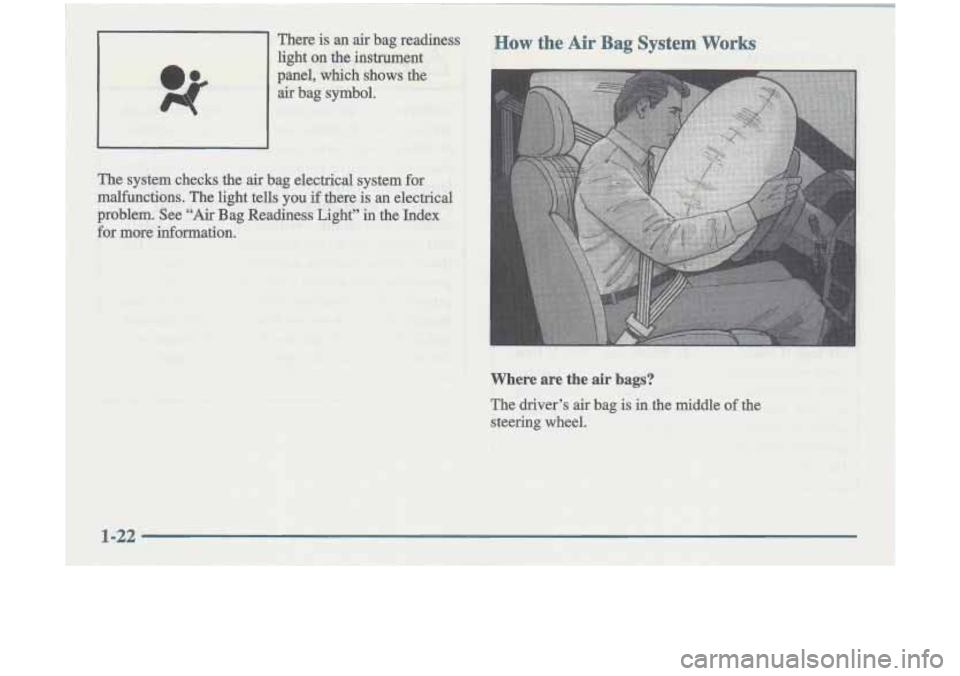
Where are the air bags?
The driver's air bag is in the middle of the
steering wheel.
Page 36 of 348
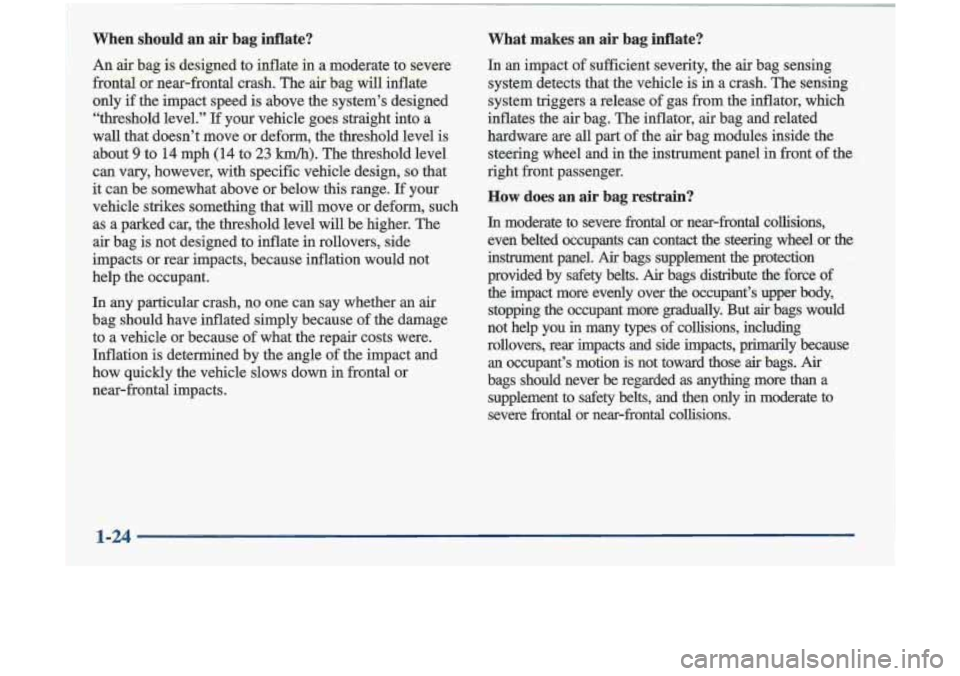
When
An air
should an air bag inflate?
bag is designed to inflate in a moderate to severe
frontal or near-frontal crash. The air bag will inflate only if the impact speed is above the system’s designed
“threshold level.”
If your vehicle goes straight into a
wall that doesn’t move or deform, the threshold level is
about
9 to 14 mph (14 to 23 km/h). The threshold level
can vary, however, with specific vehicle design,
so that
it can be somewhat above or below this range. If your
vehicle strikes something that will move or deform, such as a parked car, the threshold level will be higher. The
air bag is not designed to inflate in rollovers, side
impacts or rear impacts, because inflation would not
help the occupant.
In any particular crash, no one can say whether an air
bag should have inflated simply because of the damage
to a vehicle or because of what the repair costs were.
Inflation is determined by the angle of the impact and
how quickly the vehicle slows down in frontal or
near-frontal impacts.
~~ , ~ ~~ . ~~~ . ~~
What makes an air bag inflate?
In an impact of sufficient severity, the air bag sensing
system detects that the vehicle is in a crash. The sensing
system triggers a release of gas from the inflator, which
inflates the air bag. The inflator, air bag and related
hardware are all part of the air bag modules inside the
steering wheel and in the instrument panel in front
of the
right front passenger.
How does an air bag restrain?
In moderate to severe frontal or near-frontal collisions,
even belted occupants can contact the steering wheel or the
instrument panel.
Air bags supplement the protection
provided by safety belts.
Air bags distribute the force of
the impact more evenly over the occupant’s upper body, stopping the occupant more gradually. But
air bags would
not help you
in many types of collisions, including
rollovers, rear impacts and side impacts, primarily because
an occupant’s motion is not toward those
air bags. Air
bags should never be regarded as anythng more than a
supplement to safety belts, and then only
in moderate to
severe frontal or near-frontal collisions.
1-24
Page 37 of 348
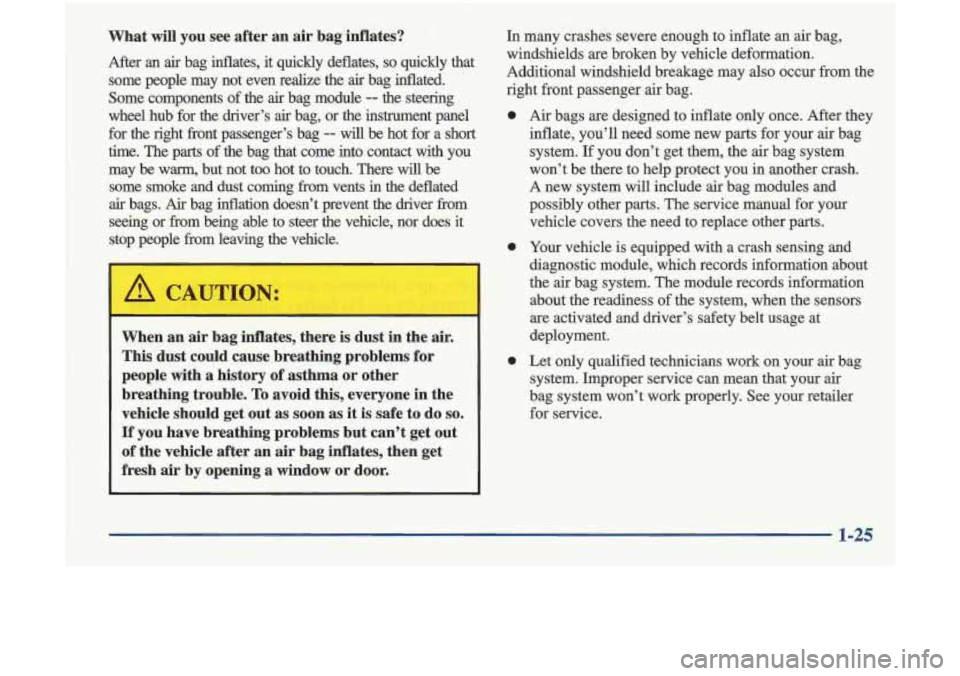
What will you see after an air bag inflates?
After an air bag inflates, it quickly deflates, so quickly that
some people may not even realize the
air bag inflated.
Some components of the
air bag module -- the steering
wheel hub for the driver’s
air bag, or the instrument panel
for the right front passenger’s bag
-- will be hot for a short
time. The parts of the bag that come into contact with you
may be wm, but not too hot to touch. There
will be
some smoke and dust coming from vents in the deflated
air bags. Air bag inflation doesn’t prevent the driver kom
seeing or from being able to steer the vehicle, nor does
it
stop people kom leaving the vehicle.
I
L
~ ~~ ~~
When an air bag inflates, there is dust in the air.
This dust could cause breathing problems for
people with a history of asthma
or other
breathing trouble.
To avoid this, everyone m the
vehicle should get out as
soon as it is safe to do so.
If you have breathing problems but can’t get out
of the vehicle after an air bag inflates, then get
fresh air by opening a window or door.
I
In many crashes severe enough to inflate an air bag,
windshields are broken by vehicle deformation.
Additional windshield breakage may also occur from the
right front passenger air bag.
0
0
0
Air bags are designed to inflate only once. After they
inflate, you’ll need some new parts for your air bag
system. If you don’t get them, the
air bag system
won’t be there to help protect you in another crash.
A new system will include air bag modules and
possibly other parts. The service manual for your
vehicle covers the need to replace other parts.
Your vehicle is equipped with a crash sensing and
diagnostic module, which records information about
the
air bag system. The module records information
about the readiness of the system, when the sensors
are activated and driver’s
safety belt usage at
deployment.
Let only qualified technicians work
on your air bag
system. Improper service can mean that your air
bag system won’t work properly. See your retailer
for service.
1-25
Page 38 of 348
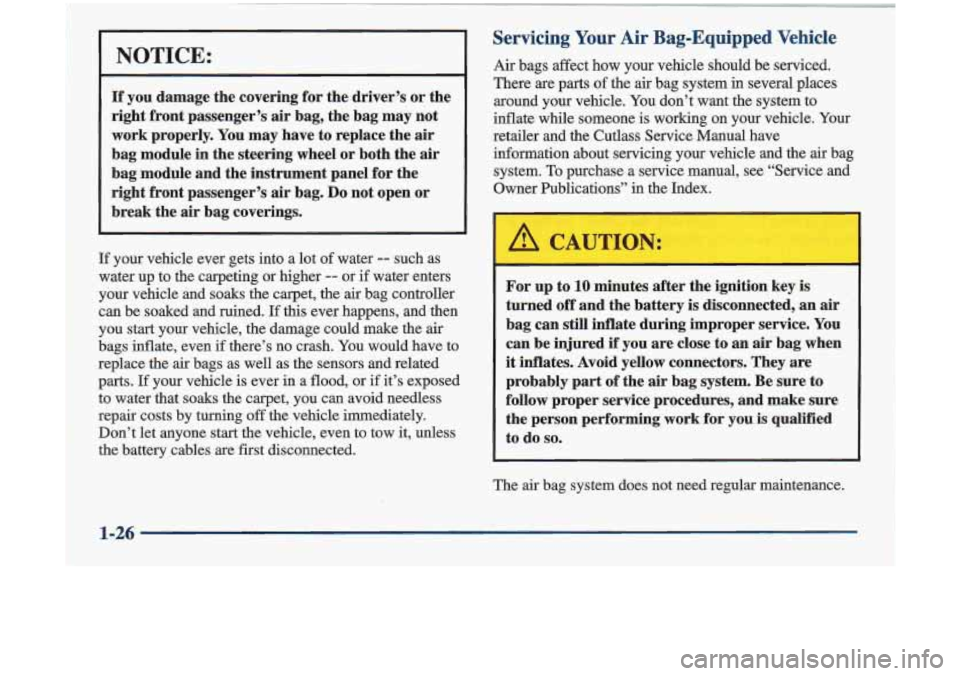
NOTICE:
If you damage the covering for the driver’s or the
right front passenger’s air bag, the bag may not
work properly. You may have to replace the
air
bag module in the steering wheel or both the air
bag module and the instrument panel for the
right front passenger’s
air bag. Do not open or
break the
air bag coverings.
If your vehicle ever gets into a lot of water -- such as
water up to the carpeting or higher
-- or if water enters
your vehicle and soaks the carpet, the air bag controller
can be soaked and ruined. If this ever happens, and then
you start your vehicle, the damage could make the air
bags inflate, even
if there’s no crash. You would have to
replace the air bags as well as the sensors and related
parts. If your vehicle is ever in a flood, or if it’s exposed
to water that soaks the carpet, you can avoid needless
repair costs by turning off the vehicle immediately.
Don’t let anyone start the vehicle, even to tow it, unless \
the battery cables are first disconnected.
~~ ~~~
~~
Servicing Your Air Bag-Equipped Vehicle
Air bags affect how your vehicle should be serviced.
There are parts
of the air bag system in several places
around your vehicle. You don’t want the system to
inflate while someone is working on your vehicle. Your
retailer and the Cutlass Service Manual have
information about servicing your vehicle and the air bag
system. To purchase a service manual, see “Service and
Owner Publications” in the Index.
For up to 10 minutes after the ignition key is
turned off and the battery is disconnected, an air
bag can still inflate during improper service. You
can be injured
if you are close to an air bag when
it inflates. Avoid yellow connectors. They are
probably part of the air bag system. Be sure to
follow proper service procedures, and make sure
the person performing work for you
is qualified
to do
so.
The air bag system does not need regular maintenance.
1-26
Page 92 of 348
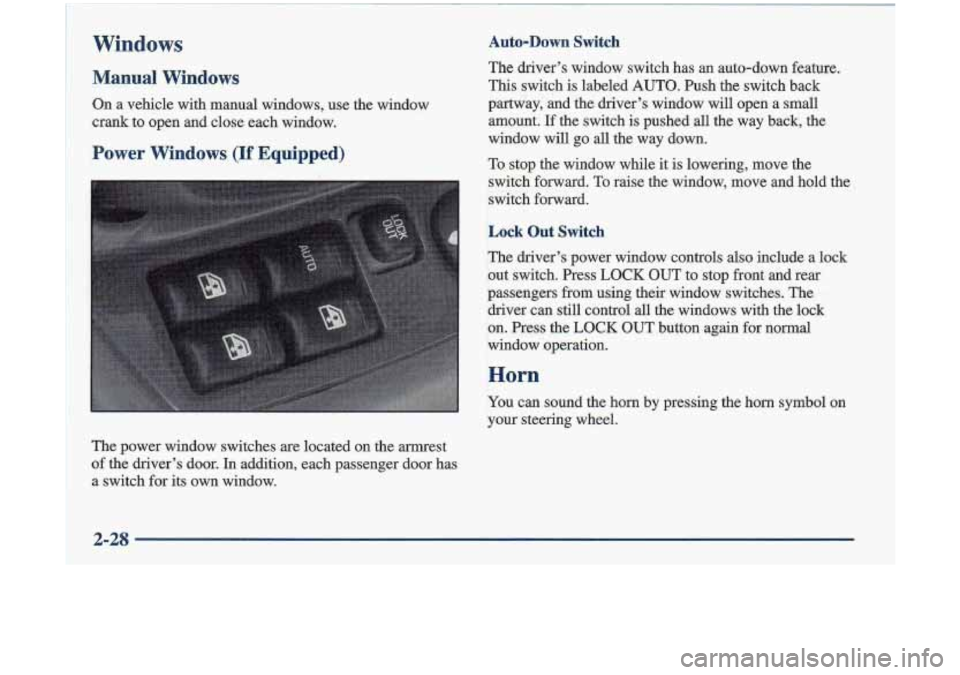
Windows
Manual Windows
On a vehicle with manual windows, use the window
crank to open and close each window.
Power Windows (If Equipped)
The power window switches are located on the armrest
of the driver’s door.
In addition, each passenger door has
a switch for its own window.
Auto-Down switch
The driver’s window switch has an auto-down feature.
This switch is labeled AUTO. Push the switch back
partway, and the driver’s window will open a small
amount.
If the switch is pushed all the way back, the
window will go all the way down.
To stop the window while it
is lowering, move the
switch forward. To raise the window, move and hold the
switch forward.
Lock Out Switch
The driver’s power window controls also include a lock
out switch. Press
LOCK OUT to stop front and reat
passengers from using their window switches. The
driver can still control all the windows with the lock
on. Press the LOCK OUT button again for normal
window operation.
P .. ,.
Horn
You can sound the horn by pressing the horn symbol on
your steering wheel.
2-28
Page 98 of 348
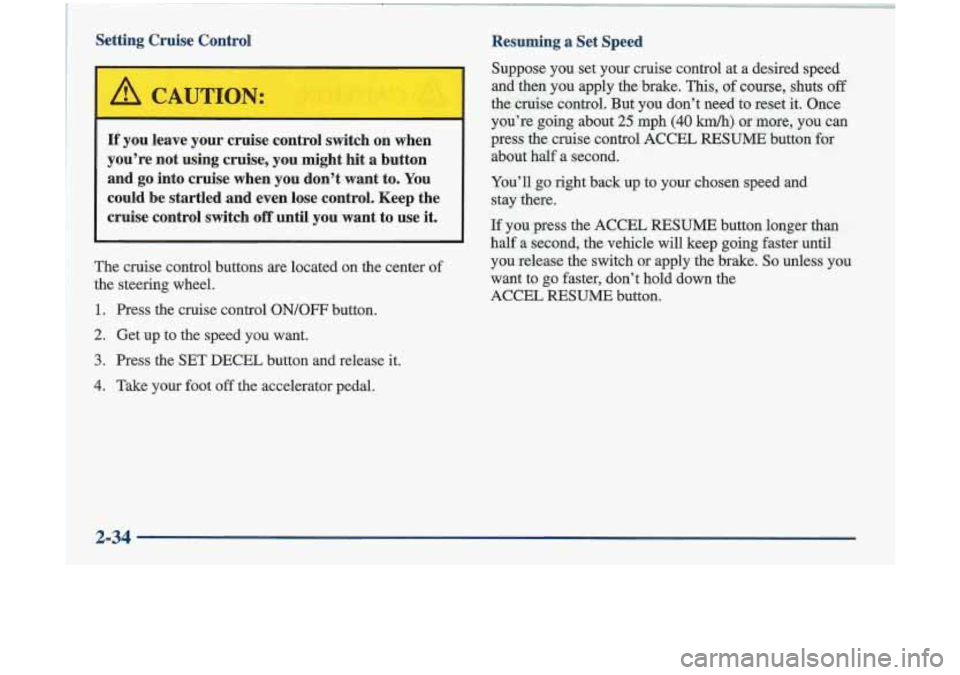
Setting Cruise Control
If you leave your cruise control switch on when
you’re not using
cruise, you might hit a button
and go into cruise when you don’t want to. You
could be startled and even lose control. Keep the
cruise control switch
off until you want to use it.
The cruise control buttons are located on the center of
the steering wheel.
1. Press the cruise control ON/OFF button. Resuming a Set Speed
Suppose you
set your cruise control at a desired speed
and then you apply the brake.
This, of course, shuts off
the cruise control. But you don’t need to reset it. Once
you’re going about
25 mph (40 km/h) or more, you can
press the cruise control ACCEL
RESUME button for
about half a second.
You’ll go right back up to your chosen speed and
stay there.
If you press the ACCEL RESUME button longer than
half a second, the vehicle will keep going faster until
you release the switch or apply the brake.
So unless you
want to go faster, don’t hold down the
ACCEL
RESUME button.
2. Get up to the speed you want.
3. Press the SET DECEL button and release it.
4. Take your foot off the accelerator pedal.
2-34
Page 102 of 348
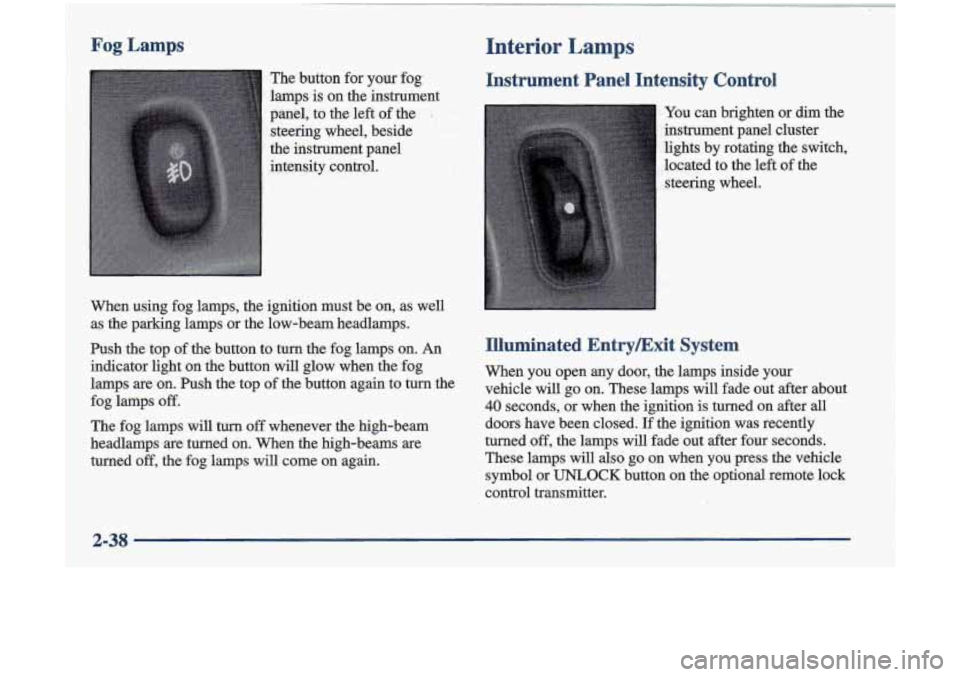
Fog Lamps
The button for your fog.
lamps is on the instrument
panel, to the left of the
I
steering wheel, beside
the instrument panel
intensity control.
When using fog lamps, the ignition must be on, as well
as the parking lamps or the low-beam headlamps.
Ish the top of the button to turn the fog lamps on. An
indicator light on the button will glow when the fog
.lamps
are on. Push the top of the button again to turn the
The fog lamps will
turn off whenever the high-beam
-headlamps
are turned on. When the high-beams are
turned
off, the fog lamps will come on again.
fog
lamps
off.
Interior Lamps . ..
Instrument Panel Intensity Control
You can brighten or dim the
instrument panel cluster
lights by rotating the switch,
located to the left
of the
steering wheel.
Illuminated EntryExit System
When you open any door, the lamps inside your
vehicle will
go on. These lamps will fade out after about
40 seconds, or when the ignition is turned on after all
doors have been closed. If the ignition was recently
turned
off, the lamps will fade out after four seconds.
These lamps will
also go on when you press the vehicle
symbol or
UNLOCK button on the optional remote lock
control transmitter.
2-38
Page 155 of 348
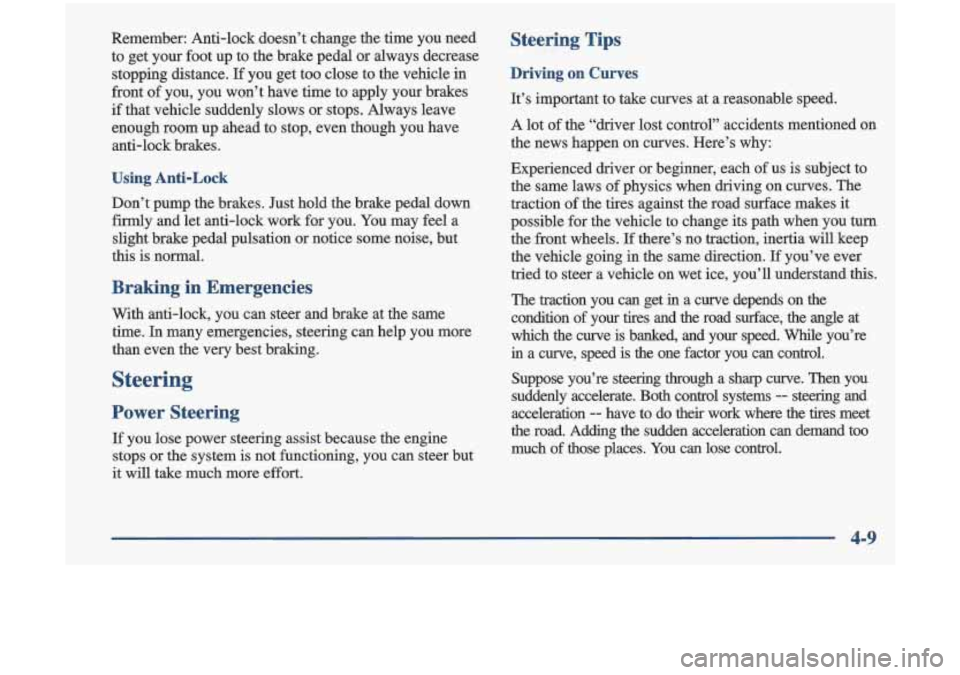
Remember: Anti-lock doesn’t change the time you neea
to get your foot up to the brake pedal or always decrease
stopping distance.
If you get too close to the vehicle in
front of you, you won’t have time to apply your brakes
if that vehicle suddenly slows or stops. Always leave
enough room up ahead to stop, even though you have
anti-lock brakes.
Using Anti-Lock
Don’t pump the brakes. Just hold the brake pedal down
firmly and let anti-lock work for you. You may feel a
slight brake pedal pulsation
or notice some noise, but
this is normal.
Braking in Emergencies
With anti-lock, you can steer and brake at the same
time. In many emergencies, steering can help you more
than even the very best braking.
Steering
Power Steering
If you lose power steering assist because the engine
stops or the system is not functioning, you can steer but
it will take much more effort.
Steering Tips
Driving on Curves
It’s important to take curves at a reasonable speed.
A lot of the “driver lost control” accidents mentioned
on
the news happen on curves. Here’s why:
Experienced driver or beginner, each of us is subject to
the same laws of physics when driving on curves. The
traction
of the tires against the road surface makes it
possible for the vehicle to change its path when you
turn
the front wheels. If there’s no traction, inertia will keep
the vehicle going in the same direction.
If you’ve ever
tried to steer a vehicle on wet ice, you’ll understand
this.
The traction you can get in a curve depends on the
condition of your tires and the road surface,
the angle at
which the curve is banked, and your speed. While you’re
in a curve, speed is the one factor you can control.
Suppose you’re steering through a sharp curve. Then you
suddenly accelerate. Both control systems
- steering and
acceleration
-- have to do their work where the tires meet
the road. Adding the sudden acceleration can demand too
much
of those places. You can lose control.
4-9
Page 156 of 348
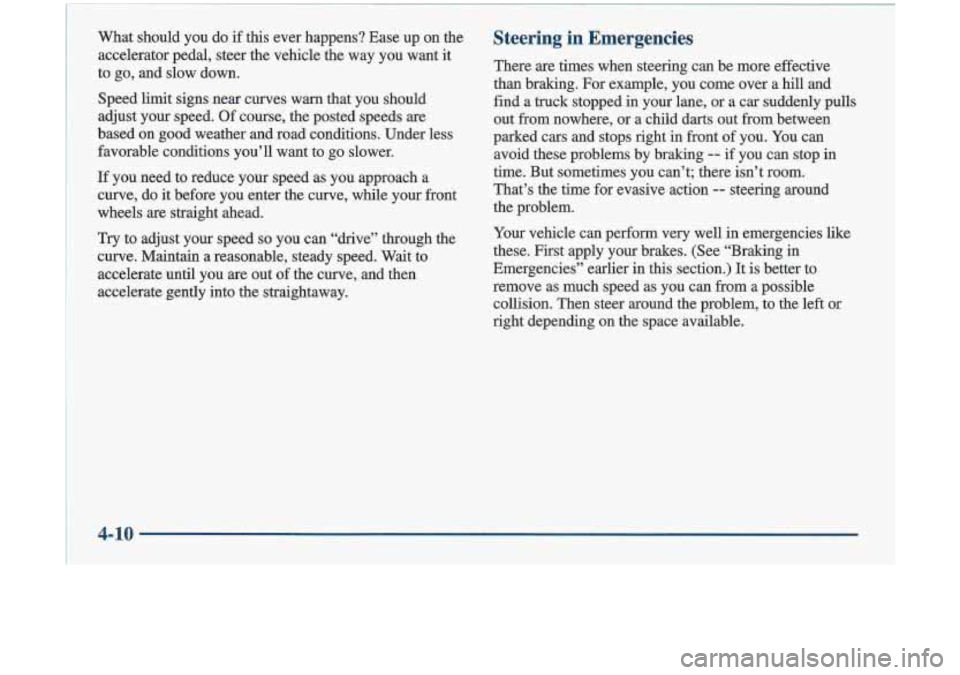
What should you do if this ever happens? Ease up on the
accelerator pedal, steer the vehicle the way you want it
to go, and slow down.
Speed
limit signs near curves warn that you should
adjust your speed. Of course, the posted speeds are
based on good weather and road conditions. Under less
favorable conditions you’ll want to go slower.
If you need to reduce your speed as you approach a
curve, do it before you enter the curve, while your front
wheels are straight ahead.
Try to adjust your speed
so you can “drive” through the
curve. Maintain a reasonable, steady speed. Wait to
accelerate until you are out of the curve, and then
accelerate gently into the straightaway.
Steering in Emergencies
There are times when steering can be more effective
than braking. For example, you come over
a hill and
find a truck stopped in your lane, or a car suddenly pulls
out from nowhere, or a child darts out from between
parked cars and stops right in front of you. You can
avoid these problems by braking
-- if you can stop in
time. But sometimes you can’t; there isn’t room.
That’s the time for evasive action
-- steering around
the problem.
Your vehicle can perform very well in emergencies like
these. First apply your brakes. (See “Braking in
Emergencies” earlier in this section.) It is better to
remove
as much speed as you can from a possible
collision. Then steer around the problem, to the left or
right depending on the space available.
4-10
Page 157 of 348

Off-Road Recovery
I
I'
An emergency like this requires close attention and a
quick decision. If you are holding the steering wheel at
the recommended
9 and 3 o'clock positions, you can
turn it a full 180 degrees very quickly without removing
either hand.
But you have to act fast, steer quickly, and
just as quickly straighten the wheel once you have
avoided the object.
The fact that such emergency situations are always
possible is a good reason to practice defensive driving at
all times and wear safety belts properly. You may find that your right wheels have dropped
off the
edge
of a road onto the shoulder while you're driving.
I OFF-ROAD RECOVERY /
w-/ T/ edge of paved surface
If the level of the shoulder is only slightly below the
pavement, recovery should be fairly easy. Ease
off the
accelerator and then,
if there is nothing in the way, steer so
that your vehicle straddles the edge of the pavement. You
can
turn the steering wheel up to one-quarter turn until the
right fiont
tire contacts the pavement edge. Then tum your
steering wheel to go straight down the roadway.
4-11